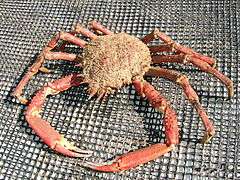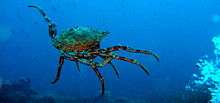Maja squinado
Maja squinado (the European spider crab, spiny spider crab or spinous spider crab) is a species of migratory crab found in the north-east Atlantic and the Mediterranean Sea.[1]
| Maja squinado | |
|---|---|
 | |
| Scientific classification | |
| Kingdom: | Animalia |
| Phylum: | Arthropoda |
| Subphylum: | Crustacea |
| Class: | Malacostraca |
| Order: | Decapoda |
| Infraorder: | Brachyura |
| Family: | Majidae |
| Genus: | Maja |
| Species: | M. squinado |
| Binomial name | |
| Maja squinado (Herbst, 1788) | |
Behavior
Migrations generally take place in autumn,[2] with some crabs covering over 100 miles (160 km) in eight months.[3] All crabs are vulnerable to predation when moulting, and M. squinado becomes gregarious around that time, presumably for defense against predators.[4] Females can produce up to four broods per year.[5] Maja squinado has been documented to feed on macroalgae and benthic inveterates. From a 1992 study done on Maja squinado in Galicia, seaweeds Laminariaceae, Corallina spp., Molluscs, the gastropods Bittium sp., Trochiidae, the bivalve Mytilus sp., echinoderms, and others were observed as part of the diet of this particular species.
Fishery
M. squinado is the subject of commercial fishery, with over 5,000 tonnes caught annually, more than 70% of it off the coast of France, over 10% off the coast of the United Kingdom, 6% from the Channel Islands, 3% from each of Spain and Ireland, 2% from Croatia, 1% from Portugal, and the remainder coming from Montenegro, Denmark and Morocco,[6] although official production figures are open to doubt.[1] The European Union imposes a minimum landing size of 120 mm for M. squinado,[7] and some individual countries have other regulations, such as a ban on landing egg-bearing females in Spain and a closed season in France and the Channel Islands.[1]
Taxonomy

A review of the species complex around M. squinado was able to differentiate between specimens from the Mediterranean Sea and those from the Atlantic, and concluded that the Atlantic specimens were a separate species, called Maja brachydactyla Balss, 1922.[8] The specific epithet squinado derives from the Provençal name for the species – squinado, esquinade, esquinado or esquinadoun — recorded by Rondelet as early as 1554.[3]
References
| Wikimedia Commons has media related to Maja squinado. |
- Carl Meyer. "Maja squinado, the European Spider Crab: Biology and Fishery". University of Hawaii. Retrieved October 4, 2010.
- E. Gonzalez–Gurriaran, J. Freire & C. Bernardez (2002). "Migratory patterns of female spider crabs Maja squinado detected using electronic tags and telemetry". Journal of Crustacean Biology. 22 (1): 91–97. doi:10.1651/0278-0372(2002)022[0091:MPOFSC]2.0.CO;2. Archived from the original on 2007-01-14. Retrieved 2006-09-09.
- Le Foll, D. (November 1, 1993). "Biology and fisheries of the spider crab Maja squinado (Herbst) in western English Channel" (PDF) (in French). Ph.D. thesis, Université de Bretagne Occidentale.
- Sampedro, M. P. & E. Gonzalez–Gurriaran (2004). "Aggregating behaviour of the spider crab Maja squinado in shallow waters". Journal of Crustacean Biology. 24 (1): 168–177. doi:10.1651/C-2404.
- L. Garcia–Florez & P. Fernandez–Rueda (2000). "Reproductive biology of spider crab females (Maja brachydactyla) off the coast of Asturias (north-west Spain)". Journal of the Marine Biological Association of the United Kingdom. 80 (6): 1071–1076. doi:10.1017/S0025315400003131.
- "Global Capture Production 1950–2004". Food and Agriculture Organization. September 9, 2006.
- "Council Regulation (EEC) No 3094/86". Official Journal of the European Communities. October 7, 1986.
- Neumann, V. (1998). "A review of the Maja squinado (Crustacea : Decapoda : Brachyura) species-complex with a key to the eastern Atlantic and Mediterranean species of the genus". Journal of Natural History. 32 (10–11): 1667–1684. doi:10.1080/00222939800771191.